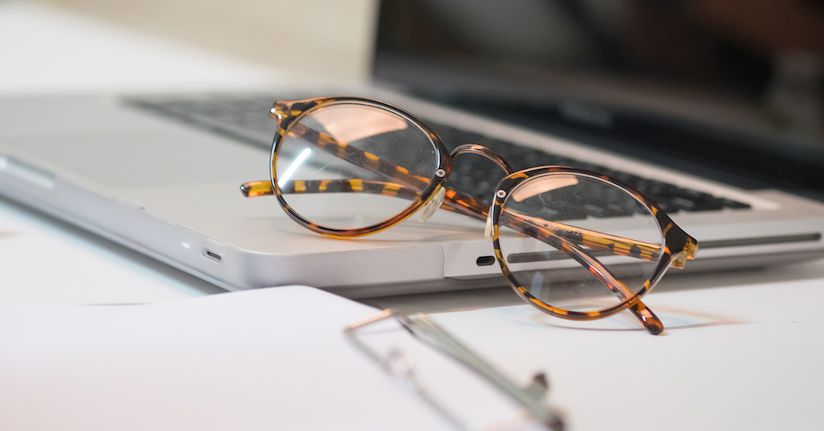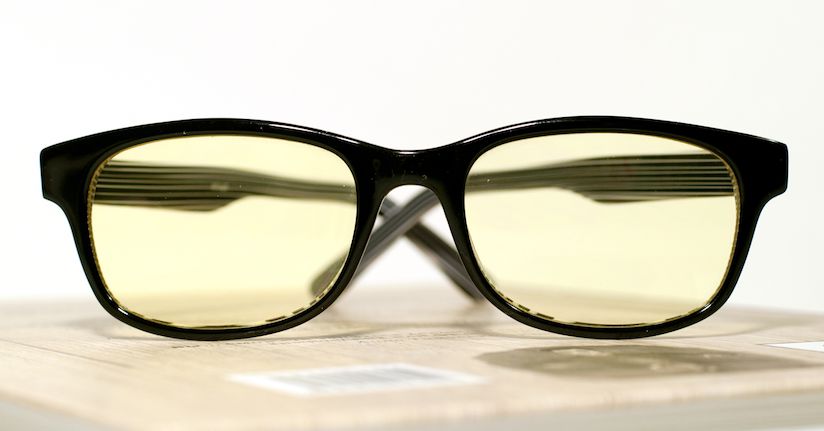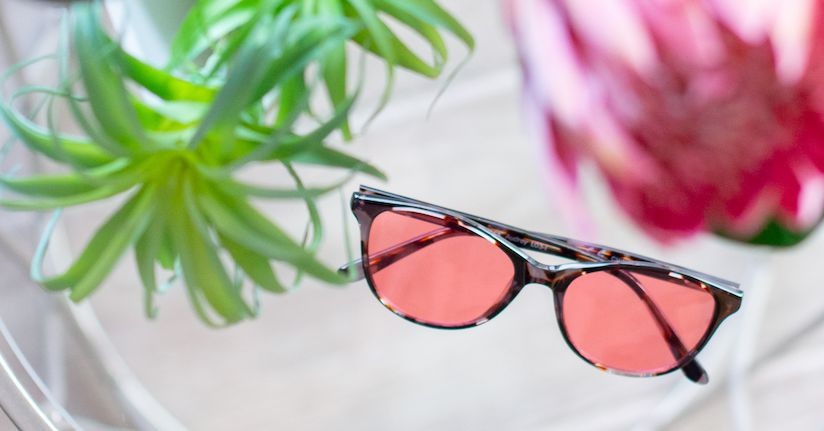FL-41 Glasses vs Other Blue Light Glasses: Which is More Protective?
For those people looking to protect themselves against blue light and all the effects that come with exposure to it (such as headaches, photophobia, migraine attacks, and other symptoms), it is important to know the differences between categories of light-filtering eyewear. Here we compare FL-41 glasses with other types of blue light glasses to help you figure out which option will be the most protective for your needs.
FL-41 glasses block blue light,
but not all equally
Glasses that are tinted properly with FL-41 do indeed filter blue light, and a significant percentage of it too. So it is not an exaggeration to say that FL-41 glasses are blue light glasses. However, blue light encompasses a range of wavelengths from 400-500nm, so specificity in exactly what wavelengths are being targeted is necessary (something you don’t always get from other brands).
The rosy-colored FL-41 tint aims for blue light at 480nm, where it reaches its peak filtering capabilities. It also blocks significant amounts of blue wavelengths below and above it—even bordering on the green spectrum of light, up to about 520nm. Although make no mistake: FL-41 does most of its beneficial work in the blue spectrum. The tint fixates on these wavelengths because clinical research has identified them as the primary light-related culprits of migraine and other light-sensitive conditions.1,2 Put simply, this portion of blue light is worse for people who have debilitating and/or ongoing light sensitivity, regardless of cause.
RELATED: The Best Blue Light Glasses for Migraine, Concussion and Light Sensitivity ➜
That said, you cannot assume that all FL-41 applications are the same. Even amongst different manufacturers of the tint, there can be significant variations in the amount of filtering that occurs. This may be the result of the lens material or differences in how the tint is applied, but either way it can lead to big differences in protectiveness against blue light.
|
Percentage of blue light removed at critical wavelengths (nm) |
||||||||
| 430nm | 440nm | 450nm | 460nm | 470nm | 480nm | 490nm | 500nm | |
| TheraSpecs FL-41 | 65% | 65% | 68% | 71% | 74% | 76% | 77% | 78% |
| Other FL-41 (Pink #1)* | 55% | 55% | 58% | 59% | 60% | 62% | 63% | 65% |
| Other FL-41 (Pink #2)* | 40% | 38% | 41% | 44% | 48% | 49% | 51% | 53% |
| Other FL-41 (Purple)* | 35% | 35% | 37% | 40% | 43% | 45% | 46% | 46% |
For example, TheraSpecs brand FL-41 glasses block nearly 80% of blue light at 480nm, while others span from 45-62% at the same wavelength.3 TheraSpecs are also more effective in the surrounding range as well when compared with other FL-41 brands, meaning they give more protection from a broader sample of harmful blue light. Still, any FL-41 glasses are almost certainly going to be a better alternative than other classes of blue light filtering eyewear—at least if you have a condition that causes photophobia.
Now let’s look at how some of those other types of blue light glasses stack up again FL-41.
FL-41 Glasses vs Clear (or Nearly-Clear) Blue Light Glasses

When most people think of “blue light glasses,” they probably picture lenses that lack any noticeable color or tint. These lenses are purported to ease digital eye strain for the millions of people who are exposed to blue light from their screens on a semi-regular or regular basis.
As you might imagine, the reason they can claim effective blue light filtering while still being clear or mostly clear has to do with the wavelengths they target. These lenses concentrate on the highest-energy blue light but do very little beyond 410nm, let alone amongst the light that is most likely to trigger people with light sensitivity.3 FL-41 glasses, on the other hand, can cut down on as much as 25 times more blue light at 480nm—at least in the case of TheraSpecs FL-41 products—than some of the most popular clear blue light glasses brands; they still outperform them throughout the vast majority of the blue light spectrum as well.
|
Percentage of blue light removed at critical wavelengths (nm) |
||||||||
| 420nm | 430nm | 440nm | 450nm | 460nm | 470nm | 480nm | 490nm | |
| TheraSpecs FL-41 | 72% | 65% | 65% | 68% | 71% | 74% | 76% | 77% |
| Warby Parker® | 35% | 5% | 3% | 2% | 2% | 2% | 2% | 2% |
| Felix Gray® (Clear) | 66% | 20% | 14% | 6% | 3% | 2% | 3% | 3% |
| TIJN Eyewear | 72% | 30% | 23% | 17% | 13% | 11% | 10% | 10% |
Now you’re probably asking: “But I’ve seen those videos where they shine a blue light through the lenses and it appears to block it entirely. How can that be?” Basically that is a marketing gimmick—a good one, but a gimmick nonetheless. Although these glasses are likely blocking some blue light, the laser usually emits a narrow band of blue light that is (not surprisingly) in the spectrum in which those lenses focus; but as we shared earlier, blue light is more than just a few wavelengths. It is exactly why authors from the New York Times recently described this testing method as a “dubious technique at best” and recommended proper lens scanning equipment and software, which is what our team uses to measure the transmission data of various glasses.
FL-41 Glasses vs Yellow Blue Light Glasses

The other notable category of blue light glasses have more of a visible tint than their clear counterparts but are still less discernible when compared with the rosy hue of FL-41. These lenses look more yellow and are marketed for computer use, sleep improvements and especially for the gaming crowd.
While not a universal principle, the more distinct the tint appears, the greater likelihood that it is doing more to keep your eyes (and brain) protected. That is certainly the case with these yellow-tinted lenses as they remove more in the middle portion of the blue light range, but they do not appear to be that much more effective when compared with clear blue light blockers. And let’s be clear: FL-41 eyewear not only competes favorably in this spectrum—with TheraSpecs FL-41 glasses blocking 2-3 times more for example—but it especially widens the filtering gap at 480nm.
|
Percentage of blue light removed at critical wavelengths (nm) |
||||||||
| 430nm | 440nm | 450nm | 460nm | 470nm | 480nm | 490nm | 500nm | |
| TheraSpecs FL-41 | 65% | 65% | 68% | 71% | 74% | 76% | 77% | 78% |
| BluTech® Lenses | 29% | 26% | 23% | 21% | 19% | 18% | 17% | 16% |
| Felix Gray® (Sleep) | 34% | 31% | 27% | 25% | 23% | 21% | 20% | 19% |
| Gunnar® | 62% | 61% | 56% | 38% | 25% | 19% | 17% | 14% |
The Final Verdict
Without a doubt, FL-41 glasses are the best option for light-sensitive disorders like migraine, brain injuries and more; they have clinical backing that shows they can reduce photophobia symptoms, decrease migraine frequency by up to 74 percent, and cut down on the damaging effects of fluorescent light exposure.4-6 Plus, as you have seen, TheraSpecs specifically are more protective due to the amount of broad and harmful blue light that they filter.
Does that mean TheraSpecs or other FL-41 glasses are right for you? Not necessarily. It certainly does not indicate that other types of blue light glasses won’t offer any relief either. Ultimately it all comes down to what you need your glasses to do.
If you want to improve your sleep or better manage any slight eye strain and headaches you experience (not tied to underlying sensitivity to light), then clear or yellow-tinted glasses may help. And certainly if light sensitivity—from screens, fluorescents, LEDs and/or sunlight—causes problems in your life because you have a chronic and/or debilitating condition, then FL-41 will offer you the most comprehensive blue light protection.
References:
1Noseda R, Kainz V, Jakubowski M, Gooley JJ, Saper CB, Digre K, Burstein R. “A neural mechanism for exacerbation of headache by light.” Nature Neuroscience 2010 Feb;13(2):239-45
2Tatsumoto M, Eda T, Ishikawa T, et al. "Light of Intrinsically Photosensitive Retinal Ganglion Cell (ipRGC) Causing Migraine Headache Exacerbation." IHC symposium OR3. June 2013.
3Visible light transmission by wavelength measured by TheraSpecs Company using f.luxometer software https://fluxometer.com/page/measure/ *Note: "Other FL-41 (Pink #1)" represented by SomniLight FL-41 indoor glasses, "Other FL-41 (Pink #2)" represented by Terramed FL-41 glasses, and “Other FL-41 (Purple)” represented by Axon Optics indoor lenses.
4Blackburn MK, Lamb RD, Digre KB, et al. FL-41 tint improves blink frequency, light sensitivity, and functional limitations in patients with benign essential blepharospasm. Ophthalmology. 2009;116(5):997-1001. doi:10.1016/j.ophtha.2008.12.031.
5Good PA, Taylor RH, Mortimer MJ. “The use of tinted glasses in childhood migraine.” Headache. 1991 Sep;31(8):533-6.
6Wilkins AJ, Wilkinson P. A tint to reduce eye-strain from fluorescent lighting? Preliminary observations. Ophthalmic Physiol Opt. 1991;11(2):172-175. doi:10.1111/j.1475-1313.1991.tb00217.x
Special note: All trademarks are property of their respective owners
TheraSpecs Glasses for Light Management
Try our light-filtering glasses and stay protected against harsh light from screens, fluorescents, LEDs, unwanted blue light, bright sunlight, flashing lights, and more.





